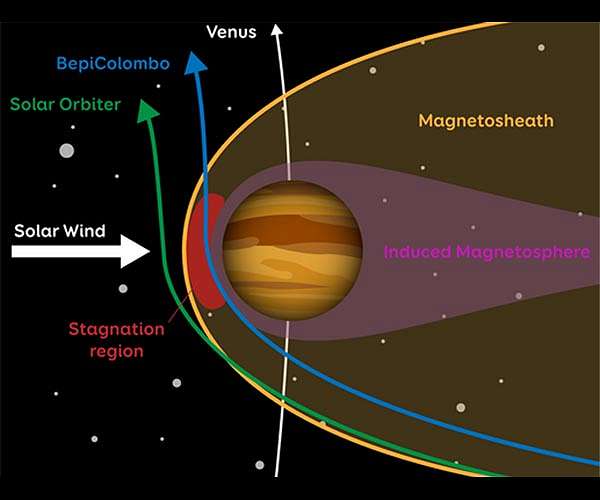
BepiColombo and Solar Orbiter compare notes at Venus (Image Credit: Space Daily)
The convergence of two spacecraft at Venus in August 2021 has given a unique insight into how the planet is able to retain its thick atmosphere without the protection of a global magnetic field.
The ESA/JAXA BepiColombo mission, enroute to study Mercury, and the ESA/NASA Solar Orbiter, which is observing the Sun from different perspectives, are both using a number of gravity-assists from Venus to change their trajectories and guide them on their way. On 9-10 August 2021, the missions flew past Venus within a day of each other, sending back observations synergistically captured from eight sensors and two vantage points in space. The results have been published in Nature Communications.
Unlike Earth, Venus does not generate an intrinsic magnetic field in its core. Nonetheless, a weak, comet-shaped ‘induced magnetosphere’ is created around the planet by the interaction of the solar wind – a stream of charged particles emitted by the Sun – with electrically charged particles in Venus’s upper atmosphere. Around this magnetic bubble, the solar wind is slowed, heated and deflected like the wake of a boat in a region called ‘magnetosheath’.
During the flyby, BepiColombo swooped along the long tail of the magnetosheath and emerged through the blunt nose of the magnetic regions closest to the Sun. Meanwhile, Solar Orbiter captured a peaceful solar wind from its location upfront of Venus.
“These dual sets of observations are particularly valuable because the solar wind conditions experienced by Solar Orbiter were very stable. This meant that BepiColombo had a perfect view of the different regions within the magnetosheath and magnetosphere, undisturbed by fluctuations from solar activity,” said lead-author Moa Persson of the University of Tokyo in Kashiwa, Japan, who was funded to carry out the study by the European Commission through the Europlanet 2024 Research Infrastructure (RI) project.
BepiColombo’s flyby was a rare opportunity to investigate the ‘stagnation region’, an area at the nose of the magnetosphere where some of the largest effects of the interaction between Venus and the solar wind are observed. The data gathered gave the first experimental evidence that charged particles in this region are slowed significantly by the interactions between the solar wind and Venus, and that the zone extends to an unexpectedly large distance of 1,900 kilometres above the planet’s surface.
The observations also showed that the induced magnetosphere provides a stable barrier that protects the atmosphere of Venus from being eroded by the solar wind. This protection remains robust even during solar minimum, when lower ultraviolet emissions from the Sun reduce the strength of the currents that generate the induced magnetosphere. The finding, which is contrary to previous predictions, sheds new light on the connection between magnetic fields and atmospheric loss due to the solar wind.
‘The effectiveness of an induced magnetosphere in helping a planet retain its atmosphere has implications for understanding the habitability of exoplanets without internally-generated magnetic fields,” said co-author Sae Aizawa of JAXA’s Institute of Space and Astronautical Science (ISAS).
BepiColombo comprises a pair of spacecraft, Mio, the JAXA-led Mercury Magnetospheric Orbiter, and MPO, the ESA-led Mercury Planetary Orbiter, which have been stacked together for the journey to Mercury. The study combined data from Mio’s four particle sensors, the magnetometer and another particle instrument on MPO, and the magnetometer and solar wind analyser on Solar Orbiter. Europlanet’s SPIDER space weather modelling tools enabled the researchers to track in detail how features in the solar wind observed by Solar Orbiter were affected as they propagated towards BepiColombo through the venusian magnetosheath.
“The important results of this study demonstrate how turning sensors on during planetary flybys and cruise phases can lead to unique science,” said co-author Nicolas Andre, the coordinator of the Europlanet SPIDER service at the Institut de Recherche en Astrophysique et Planetologie (IRAP) in Toulouse, France.
Research Report:BepiColombo mission confirms stagnation region of Venus and reveals its large extent
Related Links
Europlanet
Venus Express News and Venusian Science
|
|
Tweet |
|
|
|
We need your help. The SpaceDaily news network continues to grow but revenues have never been harder to maintain. With the rise of Ad Blockers, and Facebook – our traditional revenue sources via quality network advertising continues to decline. And unlike so many other news sites, we don’t have a paywall – with those annoying usernames and passwords. Our news coverage takes time and effort to publish 365 days a year. If you find our news sites informative and useful then please consider becoming a regular supporter or for now make a one off contribution. |
||
|
SpaceDaily Monthly Supporter $5+ Billed Monthly |
SpaceDaily Contributor $5 Billed Once credit card or paypal |
|
Massive Volcanism May Have Altered Ancient Venus’ Climate
Greenbelt MD (SPX) Nov 18, 2022
Volcanic activity lasting hundreds to thousands of centuries and erupting massive amounts of material may have helped transform Venus from a temperate and wet world to the acidic hothouse it is today, a NASA paper suggests.
The paper also discusses these “large igneous provinces” in Earth’s history which caused several mass extinctions on our own planet millions of years ago.
“By understanding the record of large igneous provinces on Earth and Venus, we can determine if these events may have … read more








